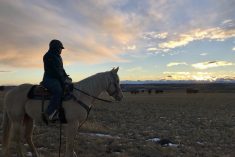The ants may never know why they arrived at the top of a plant stem, but researchers at Agriculture and Agri-Food Canada are unravelling the mystery for them. The villain in this piece is a ruthless parasite that takes control of unwary ants, using them as a vehicle to reach its final destination, the liver of grazing animals.
In emulation of a B-grade horror movie, the parasite invades the brain of the ant, turning it into a compliant zombie that climbs to the top of a flowering plant or grass stem where it is in perfect position to be consumed by a grazing animal. The resulting infection can compromise the general health and performance of the host, which, if it happens to be livestock, can have economic consequences. Researchers are currently focused on learning more about the parasite s impact on the liver of these animals and strategies for a quick diagnosis in lessen the damage and check the westward spread of this infection.
Read Also

Reintroducing fire to Saskatchewan pastures
Pastures evolve over time. Woody plants and shrubs, which cattle can’t eat, may encroach on natural grasses. Invasive species, such…
The parasite is a flatworm, Dicrocoelium dendriticum, that infects the liver of herbivores such as cattle, sheep, deer and elk. It is one of many parasites picked up on pasture that survive inside animals through the winter. It is also relatively new to Alberta. The high levels of infection recorded in recent studies can have a significant impact on weight gain in cattle.
The appearance of this parasite in a place it hadn t been before got our attention, says Dr. Doug Colwell, a livestock parasitologist with Agriculture and Agri-Food Canada at the Lethbridge Research Centre. It appears to be thriving in the Cypress Hills.
Since this parasite is relatively new to Alberta the researchers are currently focused on learning more about its impact on the behaviour and productivity of cattle by studying controlled infections within the confines of Cypress Hills Interprovincial Park. The plan is to develop specialized diagnostic tools that can help producers and wildlife managers pick up on these subclinical infections at an early stage.
Several studies have shown that controlling parasitism in livestock results in significant savings for producers. Infection of Dicrocoelium dendriticum can induce anemia, liver damage and predisposition to other diseases. Its effects are magnified when animals suffering from poor nutrition are exposed to large numbers of the parasite. As with all forms of subclinical parasitism, the outward symptoms are not obvious, but may present in small changes in behaviour and overall condition of the animal. Dicrocoelium dendriticum is known to have a significant impact on the health of sheep but its impact on cattle still remains unclear.
Dicrocoelium dendriticum is an invader from Europe, brought to North America in sheep in the early 1930s. Not fussy about its final host, the parasite infects many grazing animals. Since its arrival, it has moved across the continent. In the late 1980s it was found in elk in the Cypress Hills region straddling the southern Alberta-Saskatchewan border. A survey in 1990 found only one beef animal infected. By 2003, the worm was found in 70 per cent of cattle surveyed. In 2004 it had spread to 95 per cent.
The parasite causes inflammation of the liver and swelling of the bile ducts. An additional concern is the ease with which the infection moves between wildlife and domestic animals.
Diagnosis is achieved through the detection of parasitic eggs in host feces. The parasite s life cycle consists of three stages and three hosts. Adult worms in an animal s liver shed thousands of eggs that exit the animal in the manure. Snails in the pasture pick up the eggs from the manure and generate balls of slime full of second-stage parasites. Foraging ants consume the slime balls and the parasite eventually migrates to brain of the ant gaining control of its motor activity. The zombie ant then carries the parasite to the top of plants where it is picked up by the grazing animal. Once ingested, the parasite migrates to the liver to complete the cycle.
Using a confocal microscope that uses a laser to image intact specimens, researchers have seen the parasite lodged in a cyst-like structure in the ant s central nervous system. They ve also observed these ants heading up to the top of pasture plants in the cool of the morning where they take a firm grip on a leaf and appear to develop lockjaw, unable to move. Videos of this behaviour show the ants apparently frozen on a leaf with just their antennae in motion. As the temperature warms up, the parasite loses control and the ants return to the ground where they resume normal foraging behaviour.
Determining how the parasite controls this behaviour in the ant is critical to finding a strategy to reduce its impact on grazing animals. At present the scientists are considering three ways the parasite may exert control. One is that it could be pressuring a nerve. Another is that this is a by-product of the ant s inflammatory response to remove the parasite. The third is that the parasite produces specific neuro-chemicals that control the behaviour of the ant. All three are under investigation.
This research is supported by the Beef Cattle Research Council and is conducted by Dr. Doug Colwell, Agriculture and Agri-Food Canada, Lethbridge Research Centre, in collaboration with Dr. Cam Goater and PhD candidate Melissa Thomson from the Department of Biological Sciences, University of Lethbridge.
SheilaTorgunrudisaregionalcommunicationsofficerwithAgricultureandAgri-FoodCanadabasedinLethbridge.















